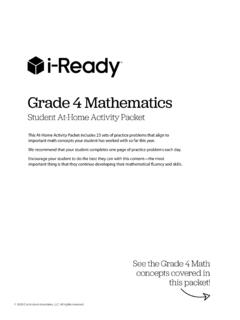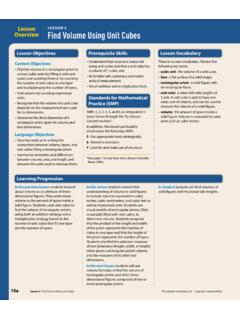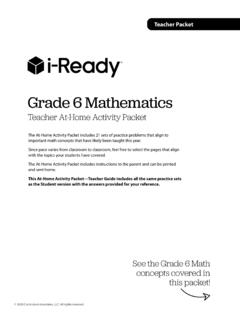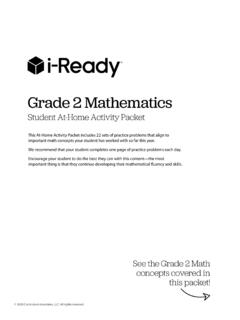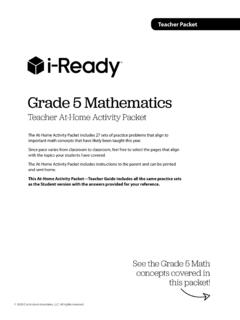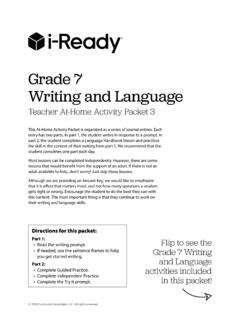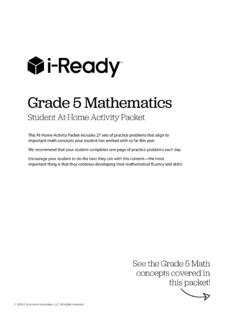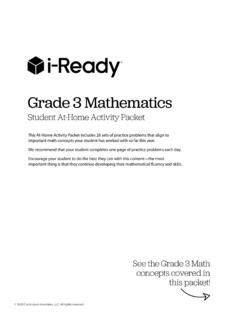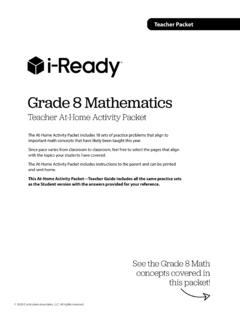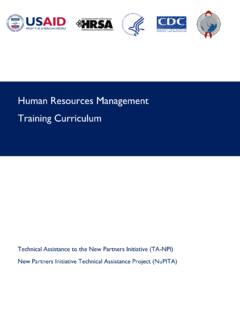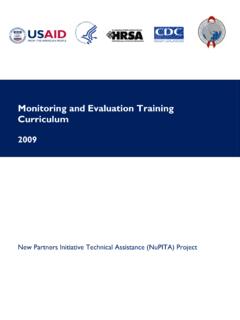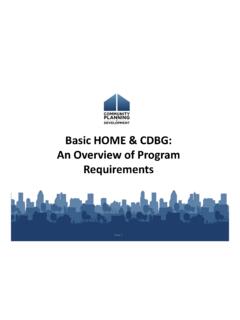Transcription of LESSON 15 Overview Understand Functions
1 Learning ProgressionLESSON 15 Overview | Understand FunctionsLESSON 15 Understand Functions Curriculum Associates, LLC Copying is not : How can you recognize a function? In the next LESSON , students will write equations for linear Functions and interpret their rates of change and initial values. Later in Grade 8, students use Functions to model and analyze real-world high school, students will continue their work with Functions , including quadratic, exponential, and trigonometric this LESSON , students explore what it means to say that an input-output rule is a function. They learn to analyze relationships presented as equations, graphs, tables of values, or verbal rules to determine which represent Functions . Students learn to classify Functions as linear or Grade 6, students learned how to use variables to represent unknown quantities in expressions and Grade 7, students extended their work with algebraic expressions and equations as they explored proportional in Grade 8, students learned to model linear relationships using tables of values, graphs, equations, and verbal Objectives Understand that a function is a rule that assigns to each input exactly one output.
2 Identify whether a relationship is a function from a verbal description, table of values, graph, or equation. Classify a function as linear or nonlinear. Interpret the equation y 5 mx 1 b as defining a linear function whose graph is a nonvertical straight Objectives Understand and use LESSON vocabulary and the adverbs exactly and only to define, write, and talk about Functions . Read descriptions, tables, graphs, and equations to determine if a relationship is a function and write short paragraphs to explain the conclusion. Take notes and paraphrase speakers ideas about how a table can help predict the shape of a Knowledge Know that every nonvertical line can be modeled by an equation of the form y 5 mx 1 b. Understand that the rate of change of a linear relationship is constant.
3 Use a linear equation to make a table of values. Sketch the graph of the line modeled by a linear Vocabularyfunction a rule in which each input results in exactly one (of a function) the independent variable of a function a function that can be represented by a linear equation. The graph of a linear function is a nonvertical straight function a function with a graph that is not a straight (of a function) the dependent variable of a the following key of a number whole numbers that multiply together to get the given number a whole number greater than 1 whose only factors are 1 and of change in a linear relationship between x and y, it tells how much y changes when x changes by angles two angles whose measures sum to 180 .Academic Vocabularyclassify to sort or decide that something can be put into a FOCUSThis Understand LESSON extends students understanding of proportional relationships and linear equations to the concept of Functions .
4 Foundational understanding established in this LESSON supports students in developing strategies to model real-world behavior with FOR MATHEMATICAL PRACTICE (SMP) SMP 2, 3, and 7 are integrated into the Understand LESSON structure.*This LESSON provides additional support for:1 Make sense of problems and persevere in solving Look for and express regularity in repeated reasoning.* See page 1o to learn how every LESSON includes these SMP. Curriculum Associates, LLC Copying is not 15 Understand FunctionsLESSON 5 OverviewUNDERSTAND LESSONLESSON 15 DIFFERENTIATIONMATERIALSP acing GuideItems marked with are available on the Teacher 1 Explore Functions (35 50 min) Start (5 min) Model It (5 min) Discuss It (5 10 min) Model It (5 10 min) Discuss It (10 15 min) Close: Exit Ticket (5 min)Additional Practice (pages 351 352)Presentation Slides PREPARE Interactive Tutorial RETEACH or REINFORCE Visual ModelMaterials For display: 3 mapping diagrams (pairs of side-by-side elongated ovals)SESSION 2 Develop Understanding of Linear and Nonlinear Functions (45 60 min) Start (5 min) Model It: Graphs (5 min) Discuss It (5 10 min) Model It: Equations (5 min) Discuss It (10 15 min) Connect It (10 15 min) Close.
5 Exit Ticket (5 min)Additional Practice (pages 355 356)Presentation Slides RETEACH or REINFORCE Visual ModelMaterials For display: 30 index cards, tapeREINFORCE Fluency & Skills Practice SESSION 3 Refine Ideas About Functions (45 60 min) Start (5 min) Apply It (35 50 min) Close: Exit Ticket (5 min) Math Toolkit graph paper, straightedgesPresentation Slides LESSON 15 Quiz or Digital Comprehension CheckRETEACH Tools for Instruction REINFORCE Math Center Activity EXTEND Enrichment Activity Curriculum Associates, LLC Copying is not 15 Understand FunctionsLESSON 15 Overview | Understand FunctionsDIFFERENTIATION | ENGLISH LANGUAGE LEARNERSSESSION 1 Model It Ask students if they like to eat mangos. Do they prefer eating the raw fruit, drinking mango smoothies, or using mangos in cooking?
6 Invite students to share what they know about this fruit. They may be surprised to learn that the fruit is not the only valuable part of the mango tree. Bark, leaves, flowers, seed pits, and even the skin of the fruit have been used in traditional medicines from ancient times, continuing in this modern age. Many students will know that mangos are grown in the Caribbean. Mangos currently flourish in most tropical regions, but they were first grown in India over 5,000 years ago. India produces more mangos than any other country in the world. Mangos are exchanged as gifts of love and 2 Model It Birdhouses come in many shapes, sizes, and colors. A birdhouse may look like a small house, a tea pot, or even a cat! There is a science behind birdhouses, though. Birdhouses are made for cavity-nesting birds, those that naturally excavate holes in which to build their nests.
7 The entrance hole must be just the right size. It must be big enough to let birds in and small enough to keep predators out. Perches can make it easier for predators to get to the birds, so it is best to leave them off. While the outside may be highly decorated, it is best to leave the interior unpainted. A rough surface makes it easier for new baby birds to move and climb. Invite students to share a time they had a birdhouse on their property or watched birds tending a 3 Apply It Problem 1 Rolling balls at target items, like pins, has been a popular pastime for thousands of years. Evidence in Egypt of an early form of bowling suggests that people have enjoyed this sport since 3200 BCE. The game has changed over time and varies from country to country. In the United States, ten-pin bowling is most popular.
8 European bowlers, however, prefer nine-pin bowling. In the nine-pin version, the center pin is colored red and is called the King Pin. Scoring is more complicated in nine-pin bowling and depends on which specific pins are knocked down and which are left standing. Nine-pin bowling was once wildly popular in the United States. In the 1930s, nine-pin bowling was legally banned across the because people would skip work to play. Today, nine-pin bowling is still banned in every state except Texas! Ask if any students have seen or played nine-pin bowling and invite students to share their experiences with ten-pin to Culture Use these activities to connect with and leverage the diverse backgrounds and experiences of all students. Engage students in sharing what they know about contexts before you add the information given here.
9 DIFFERENTIATION | ENGLISH LANGUAGE LEARNERSUse with Session 1 Discuss ItOverviewLESSON 15 Understand LESSON347 348 LESSON 15 Understand Functions Curriculum Associates, LLC Copying is not to Language For English language learners, use the Differentiation chart to scaffold the language in each session. Use the Academic Vocabulary routine for academic terms before Session 1. Connect to Family and Community After the Explore session, have students use the Family Letter to let their families know what they are learning and to encourage family 3 5: Speaking/ListeningPrepare students to answer the question in the first Discuss It. Display the LESSON terms input and output. Then have students read Model It problem 1b. Have students turn to partners and use the math terms to describe the table.
10 Then ask them to read the question in Discuss It. If students need clarification, call on volunteers to Say It Another Way. Encourage students to discuss some examples before they answer the question. Ask: What are some of the inputs that have the same output? Why is the output the same? Encourage students to use for, to, and, both, and because to 2 4: Speaking/ListeningPrepare students to answer the question in the first Discuss It. Display the LESSON terms input and output. Then read Model It problem 1b with students. Call on volunteers to explain the meaning of 2-student desk. Then have students turn to partners and take turns explaining the input and output for each column in the table. Next, help students read the question in Discuss It. Have partners talk about different inputs that have the same output.
